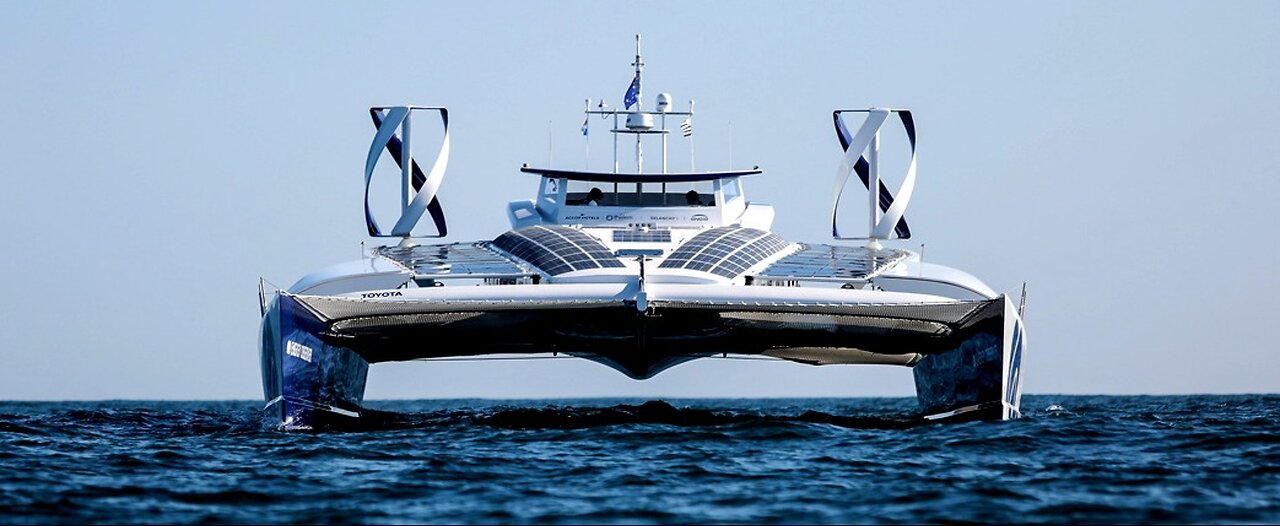Premium Only Content

Wind, Solar, HHO, Powered Boat
Powered by solar, hydrogen, wind and water energy, the white catamaran will take six years to tour the world.
During its stopovers, Energy Observer produced a total of 488 kg, almost ½ ton of hydrogen, during 1496 hours of functioning, that's an efficiency of 42%.
Hydrogen supplied up to 60% of the energy needed for a typical voyage, and the remaining 40% was attributed to solar power, using a fuel cell functioning on average for 6 of each 24 hours of navigation, with an efficiency of 48%
On the sides of the boat are The Oceanwings wings which are going to reduce the vessel's energy consumption, accelerate its speed, and above all, enable it to produce energy and hydrogen while navigating.
The Oceanwings won't only serve as part of the rigging, they will actually increase the vessel's energy efficiency. Their installation on the vessel's two floaters will in fact allow it to:
Increase the speed, by complementing the electric motors
Reduce energy consumption when they are used to compensate the electric motors
Increase energy production during navigation by producing hydrokinetic energy (reversing the electronic motors into hydrogeneraters)
Produce hydrogen during navigation by the electrolysis of water
Up until now, hydrogen production was only possible during stopovers, but the installation of Oceanwings® will make hydrogen production possible while the vessel is navigating. It will only be for 1 to 2 hours a day in the beginning, but introducing hydro-generation by inverting the electric motors is an indispensable power supplement in Northern Europe where the sunlight conditions are not as favorable.
The installation of Oceanwings® on board Energy Observer is the first step to reducing the environmental impact of maritime transportation around the world. According to simulations carried out on a large range of boats, the results are extremely promising: from 18% to 42% less energy is required. An important statistic when one recognises that 90% of global commerce is transported at sea. Maritime transportation is also responsible for large quantities of air pollution, emitting into the atmosphere pollutants such as fine particles, nitrogen oxide (NOx), and sulfur oxide (SOx).
Hydrogen is the most abundant chemical element in the universe. Inexhaustible, it displays exceptional energy density: it releases up to 4 times more energy than coal, 3 times more than diesel and 2.5 times more than natural gas. Its combustion emits neither greenhouse gases nor fine particles. Thus, Energy Observer is the first vessel in the world that is capable of producing its hydrogen on board using sea water, by electrolysis.
-
 45:56
45:56
Kimberly Guilfoyle
16 hours agoNew Year. Same MAGA Mission, Live with Roger Stone | Ep. 183
120K45 -
 1:49:14
1:49:14
2 MIKES LIVE
20 hours ago2 MIKES LIVE #160 We're Back! Deep Dive Monday!
104K23 -
 54:28
54:28
LFA TV
1 day agoTrump’s Triumphant Year | Trumpet Daily 12.30.24 7PM EST
90.8K16 -
 2:28:37
2:28:37
Quite Frankly
18 hours ago"2024 Review, Homunculus Flu, Old/New Year Predictions" 12/30/24
111K16 -
 14:04:17
14:04:17
RonjnJeremy
21 hours ago $9.64 earnedClassic Wow 20th Anniversary edition HC SF, Rogue..PT8 lvl 46+ Just need to stay alive...
126K6 -
 1:50:28
1:50:28
Jesús Enrique Rosas
18 hours agoEp. 51: Gates wants CENSORSHIP, Colbert MESSES UP, AOC meltdown, Hanks LEAVING and MOAR!
137K98 -
 1:45:47
1:45:47
The Quartering
20 hours agoHuge Censorship Law To Pass, Trump Endorses Johnson, TikTok is Saved? & Today's News!
156K96 -
 55:59
55:59
The Amber May Show
18 hours ago $1.88 earnedCommon Behaviors That May Indicate You Are In An Abusive Relationship| Grace Bishara
41.6K1 -
 1:54:42
1:54:42
MTNTOUGH Fitness Lab
15 hours agoThe MTNTOUGH 8 Week LIVE READY Challenge w/ Kyle Kamp | MTNPOD #97
33.5K -
 2:25:15
2:25:15
WeAreChange
14 hours agoTrump Make CRYPTIC Post! Bill Gates Requested Meeting With Elon Musk At Mar-a-Lago??
47.1K29